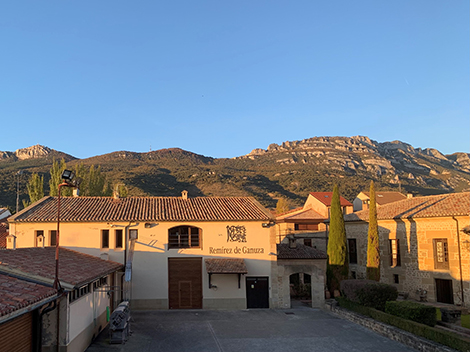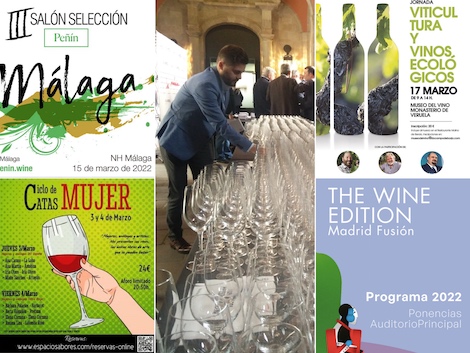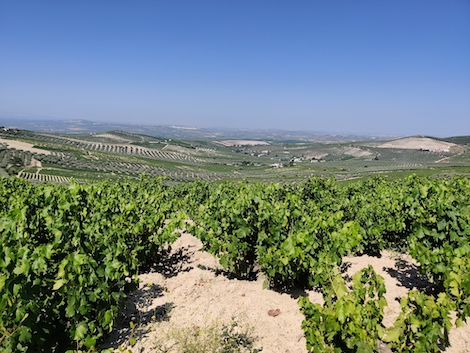
Established in 1989, Remírez de Ganuza helped to modernise Rioja in the 1990s alongside other bodegas like Artadi, Eguren, Roda, Finca Allende or Contador.
Its success rested on two great strengths. First, the vast collection of vineyards that founder Fernando Remírez de Ganuza had acquired after almost two decades buying and selling land as a broker. Secondly, the sophisticated gadgets and processes devised by Fernando himself, which are still in use at the winery.
One of them is the selection table. It is divided into three sections and the final one separates bunches into tips and shoulders. The tips have more acidity so they are destined to Erre Punto, the estate's premium carbonic maceration red, whereas the shoulders, with higher concentration, are ideal for wines meant for ageing. Other innovations include washing the grapes with their own juice before entering the tanks, or the use of a balloon-shaped bag that is gradually filled with water to slowly and gently extract the grape juice destined to the top red Trasnocho.
In the 2010s the Urtasun family, first as shareholders and later as sole owners, brought the required impetus to navigate in increasingly competitive wine markets. Fernando Remírez remained on board, but the founder concentrated his efforts on the vineyards, his great passion. In recent years, the company has focused on the sale of older vintages as part of a strategy to strengthen the brand's presence in the fine wine business, and on upgrading its white wines in line with its reds. The next step is to expose the quality of some of the estate's vineyards to deliver a more contemporary and refined expression of Rioja.
"For some years we may have seemed stagnated and lacking innovation, but we have never stopped working," Urtasun explains. Indeed, he is planning to release two new reds made from grapes grown in San Vicente de la Sonsierra (Rioja Alta). "They might not be terribly relevant in terms of volume and turnover, but they will be proof of the high-quality wines that we have at Remírez de Ganuza," he adds.
Two new reds
Iraila (September in Basque) is set to be released this spring and the first vintage is 2020. It is made from Garnacha grapes sourced from a site called La Rad in San Vicente de la Sonsierra, plus a small amount of fruit from Disabal, also in San Vicente. For the 2021, the plan is to blend a third plot called El Convento from the same village. Grapes are destemmed but are not crushed; 40% of the wine is aged in an earthenware vessel with little porosity and the rest is aged in oak. The wine is fragrant and lifted, with floral nuances (rose, violet), sweet, crunchy red fruit, lively acidity and notable length; quite a different style from the structured Tempranillo-based reds that Remírez de Ganuza is widely known for. The focus is the wine’s expression, not crafting another long-lived red meant for cellaring, although Iraila’s low pH (3.2) may well bring some surprises in this regard.
Grapes for the 2019 single-vineyard red, which will be released at a later stage, are fully sourced from La Rad, where they have managed to gather seven plots covering four hectares on the north bank of the N-232a road, on the foothills of the Sierra de Cantabria mountains. The vines are close to Peciña, one of the most captivating hamlets of San Vicente de la Sonsierra. Soils here are mostly clay and sand but the gravelly texture, says winemaker Jesús Mendoza, invigorates the vines and helps them to cope with the summer heat.
Whilst the wine will be released as Remírez de Ganuza UV (meaning unique vineyard), José Ramón Urtasun does not rule out applying for the Viñedo Singular certification at some point. The vines, planted between 1973 and 1978, have fermented separately since 2007. According to Mendoza, they have a clearly distinctive character that he describes as a combination of white pepper and blue flowers. Made from Tempranillo, UV is really expressive, with lots of spices and delicate floral aromas. Its broad palate is the result of a powerful aromatic expression rather than tannins or extraction. Half of the wine was aged in new oak, the other half in seasoned wood. Slow, long toasted oak barrels are preferred so as to preserve the original character of the wine.
Urtasun points out that he has no intention of developing a range of single vineyard wines following the Burgundy model as this could dilute the brand’s image and mislead consumers, but he acknowledges that single vineyard wines contribute to gain visibility among opinion leaders in the wine business. Retail prices are expected to reach €85-€90 for the Garnacha and €110-€120 for UV.
The evolution of the Reserva
José Ramón Urtasun is aware that the bodega’s commitment to new oak goes against current trends, which seek to blur the impact of wood in wines. But he and Jesús Mendoza aren't dogmatic on this issue. For instance, they didn't hesitate to limit the presence of new oak in the Reserva 2014 currently on release. "It was a year with generous yields and rain during the harvest, but those who worked hard to have healthy grapes were able to avoid botrytis. 2014 is a delicate vintage and we treated it as such," Mendoza explains. The style is certainly less structured than it is customary at the winery, but it is a finely textured red with subtle aromas reminiscent of red fruit, pepper and mint.
For Mendoza, great vintages in Rioja have fluidity and good pH levels, as was the case with 2018. The average weight of the berries is a reliable indicator of this "fluidity", he says. In 2018 it was for 2g compared to 1.2g in 2019 (a vintage with higher concentration) and 1.8g in 2020, which had juiciness. "Due to climate change, Tempranillo is becoming more and more powerful, so we really need to handle it very gently," Mendoza adds.
It might make less sense in the future to split bunches into tips and shoulders, Urtasun says, as wines meant for ageing may need extra freshness. Erre Punto fans shouldn't worry though; despite its small production, this cosechero (carbonic maceration) red has a very loyal fan base and will continue to be part of the range for the time being.
With around 60,000 bottles out of a total output of 180,000 in good vintages, the flagship Reserva is Remírez de Ganuza's most widely available wine. Grapes are sourced from vineyards spread in nine villages, from Labastida to Elvillar, on the foothills of Sierra de Cantabria, "but none of them plays a dominant role in the wine," Urtasun explains.
In fact, the selection has changed overtime. "We have never had so many good vineyards. Right now, we are buying rather than selling, but we will end up getting rid of some plots because we want to focus on the very best", Urtasun points out.
Some of the new acquisitions are vineyards whose grapes Remírez de Ganuza has been buying for many years. Anything the bodega buys from suppliers (about 15% of all the grapes that enter the winery) is sourced from quality vineyards under its control. In addition, Remírez de Ganuza sells grapes to other producers.
The goal is to increase production capacity (the charming, small bodega in Samaniego has reached its limits) so as to be able to process all the high-quality grapes harvested in good vintages. In the long term, Urtasun aims to produce 300,000 bottles, just like any Bordeaux château of a similar size. And the good news is that there is room for growth in the Reserva without compromising quality.
Right now, the bodega offers 10 vintages of the Reserva (the oldest is 1996) as part of its 2022 allocations. This is the most extensive selection in a catalogue that also lists verticals of Erre Punto white (six vintages), Fincas de Ganuza (four vintages), Remírez de Ganuza Gran Reserva (nine vintages) and Trasnocho (six vintages).
Whites as good as reds
The first Remírez de Ganuza white was sold under the brand Erre Punto. Like its red sibling, it was released in a Bordeaux-shaped bottle, but it was replaced in the 2013 vintage by Remírez de Ganuza Fermentado en Barrica, a barrel-aged wine sold in a Burgundy-shaped bottle. When the new Gran Reserva white was launched late last year, the barrel-fermented version was upgraded to Reserva. Prices in Spain now stand at €42 for the Reserva and €85 for the Gran Reserva -a great example of how to increase successfully quality and value. In the meantime, Remírez de Ganuza has shifted from being a red wine bodega to also becoming a respected white wine producer in Rioja.
Availability for whites is limited (28,000 bottles of the recently released Reserva 2019, and 3,000 bottles of Gran Reserva 2013). Demand outstrips supply and Urtasun is delighted with the strong presence of the Reserva in restaurants. The wine is a blend of many traditional vineyards where white grapes are planted on the upper areas or in the edges of the plots. Olagar, the vineyard planted in 1978 that is destined to the Gran Reserva, is an exception. Viura vines lie on a fairly steep slope just above La Canoca, a renowned site in San Vicente de la Sonsierra where the shallow soils naturally moderate yields.
Mendoza says that Viura can be an outstanding grape variety when it is planted in suitable soils and with the right exposure: "It has body, acidity, good pH and, as it is not too exhuberant, it reflects a site’s character very well".
Whilst Remírez de Ganuza whites may have a hint of classicism with their balanced oak ageing, the new reds will significantly broaden the house's style palette given that the Reserva is intended to show the character of traditional vineyards in the Sonsierra in each new vintage.
Following in the footsteps of an innovator like Fernando Remírez de Ganuza, José Ramón Urtasun and Jesús Mendoza seem to understand each other perfectly. As a nod to this new approach, all the wines released under the new ownership and those set to be launched soon come in Burgundy bottles.

Amaya Cervera
A wine journalist with almost 30 years' experience, she is the founder of the award-winning Spanish Wine Lover website. In 2023, she won the National Gastronomy Award for Gastronomic Communication
NEWSLETTER
Join our community of Spanish wine lovers






